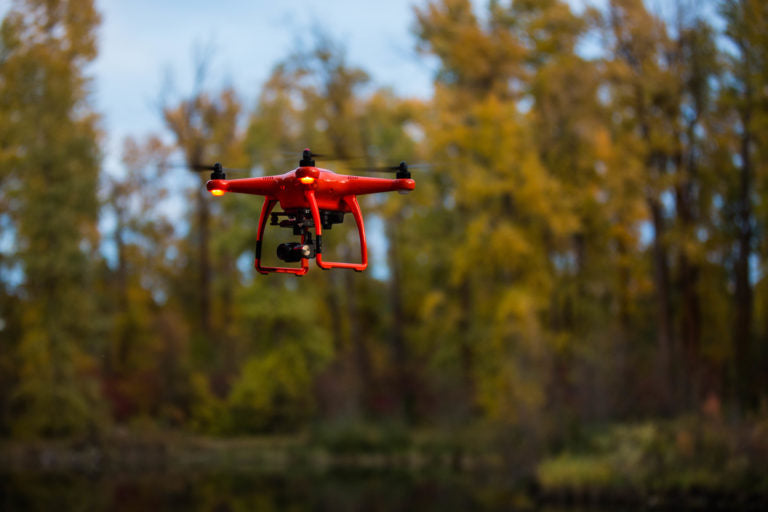
Flying Drones in Cold Weather: 3 Tips To Do It Right
We’re headed into the winter months and for many regions in the northern hemisphere this means colder temperatures. You can still fly your drone when temperatures drop, but there are several factors that make it more challenging than flying in optimal weather conditions.
Before you head out to capture aerial images of that picturesque winter landscape, take a minute to read up on how cold weather can impact your flight and to learn the steps you can take to keep your drone safe.
Challenges of cold weather flight
The biggest difference you’ll notice when flying in colder temperatures is shortened flight times. Most quadcopters use lithium-polymer (LiPo) batteries. When the weather gets cold, the chemical reactions in LiPo batteries slow down, lowering the battery capacity. A fully charged drone battery that typically provides 20-25 minutes of flight time may only provide 10-15 minutes in cold weather. In extreme cases, you might see large, unexpected drops in power levels or even experience total battery failure (though total failure is very rare).
Cold weather can also impact the drone sensors, which may cause the drone to drift or be less responsive to control inputs. Cold hands and fingers can make it more difficult to operate the controls, which can be an additional obstacle to smooth and stable flight.
Flying safely in cold conditions
Here are a few actions you can take to get the most out of your drone during cold weather flights:
Check your user manual for guidelines
Many popular quadcopters are designed to fly in temperatures that range from roughly 32°F – 104°F (0°C – 40°C), giving you the ability to safely fly in a variety of climates. If you’re flying in high altitudes or in areas with harsh seasonal weather, you might be exceeding the recommended temperature guidelines, which could put your drone at risk. Be sure to reference your user manual for instruction on safe operating conditions for the drone, gimbal, and battery.
Prioritize battery best practices
Keep the batteries warm: If you’re going to be outdoors for extended periods of time, do what you can to keep the batteries warm. For example, instead of just throwing the batteries in your backpack, wrap them up in a scarf, sweater, or glove. Some drone pilots even use hand warmers to help ensure batteries stay warm. If you’re driving to a distant location, keep the batteries in the cabin of the car instead of the trunk. These extra precautions will help extend the flight time and minimize the chances of temperature-related battery errors.
Hover after takeoff: When you first launch the drone, bring the aircraft up to 10-12 ft and let it hover for 30-60 seconds or until the battery temperature is at least 59° F (15° C). Most drones provide a way for you to check the battery temperature, either in the mobile app or on the controller itself. Hovering the drone gives the battery and motors a chance to warm up and provides you with the opportunity to confirm that the drone is stable and flying as you expect. In fact, bringing the drone up to a low altitude and letting it hover after takeoff is a great practice regardless of weather conditions.

Allowing your drone to hover for 30-60 seconds right after takeoff gives the battery and motors a chance to warm up.
Ensure batteries are fully charged: Some drone batteries include technology that automatically discharges battery power after a certain period of inactivity. This maintenance feature helps extend the battery life, but if you haven’t flown for a few weeks it can be easy to forget that your batteries may no longer be at the levels you expect. Before you head out the door, take a minute to verify that your batteries are fully charged
Minimize heavy control inputs: Flying at high speeds or at full throttle requires a heavy current from the battery and can cause a sudden voltage drop. Avoiding full throttle, especially during the first few minutes of your flight, and minimizing heavy control inputs will help extend the flight time.
Avoid draining the battery: Under normal weather conditions, maxing out the flight time and flying to a low battery level is common. But when you’re flying in cold weather, completely draining the battery can be risky. Fly until the battery drops to 30-40 percent capacity, and then bring the drone back down. Pack a few spare batteries if you know you’ll need a lot of time in the air.
Bring a portable charger for your mobile device: Many popular drones stream live video to a mobile device on the controller. Remember that the battery in this device will also be impacted by cold weather. You may want to purchase a small portable charger to power up your mobile device if needed.
Steer clear of precipitation
Most drones aren’t waterproof and precipitation of any kind can damage the camera and gimbal, short out a motor, or cause other malfunctions to the drone or controller. If your drone does get caught in the rain or snow, land it as soon as possible. Make sure to dry off the props and body of the drone. In particularly cold weather, be aware that any moisture in the gimbal pads can freeze, which can impact the quality of your aerial footage.
The Bottom Line
You can still fly your drone in cold weather, but it may require a little extra leg work before the flight and some additional caution when you’re drone is up in the air. Your flight times might be relatively short, but if you give proper attention to the batteries and prioritize best practices, your chances of consistent, safe flights are significantly improved.
